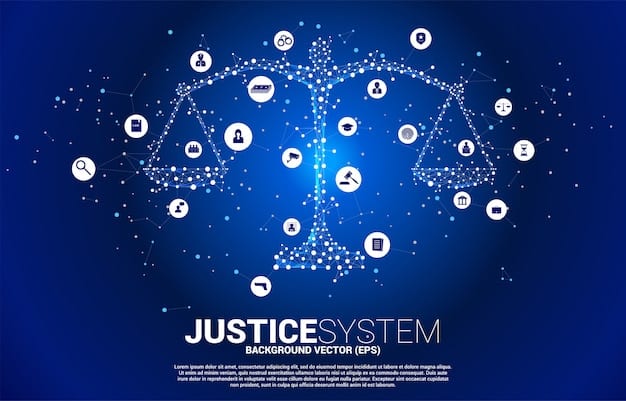State vs Federal Immigration Laws: What Mexican Immigrants Need in 2025
Navigating the complex landscape of immigration laws requires understanding the intricate balance between state and federal authorities, as Mexican immigrants in the US need to grasp their evolving rights and responsibilities in 2025 amidst shifting policies and enforcement priorities.
The intricate tapestry of United States immigration law presents a unique challenge, particularly for Mexican immigrants, as the lines between state and federal jurisdiction often blur. Understanding the nuanced interplay of these legal frameworks is not merely an academic exercise; it is fundamental to navigating daily life, ensuring compliance, and protecting rights in 2025, especially concerning Comparison/Analysis: State vs. Federal Immigration Laws: What Mexican Immigrants Need to Know in 2025.
The dual nature of immigration law: federal supremacy vs. state initiatives
Immigration law in the United States operates under a principle often referred to as federal preemption, meaning the federal government generally holds supreme authority over immigration matters. This foundational concept stems from the U.S. Constitution, specifically the Supremacy Clause, which establishes federal laws as the “supreme law of the land.” However, this federal dominance doesn’t completely preclude states from enacting laws that touch upon immigration, leading to a complex and often contested legal landscape.
Federal authority in immigration policy
The federal government, primarily through Congress, dictates broad immigration policy, including who can enter the country, how long they can stay, and the conditions for naturalization. Agencies like U.S. Citizenship and Immigration Services (USCIS), U.S. Immigration and Customs Enforcement (ICE), and Customs and Border Protection (CBP) are responsible for implementing and enforcing these federal laws. Their jurisdiction extends across all states, ensuring a somewhat uniform approach to border control, visa processing, and deportation.
- Visa issuance: Federal agencies manage all types of visas, including work, family, and tourist visas.
- Border security: The federal government is solely responsible for securing the nation’s borders and ports of entry.
- Deportation proceedings: Immigration courts, part of the Department of Justice, handle removal cases under federal statutes.
Despite this clear federal mandate, certain aspects of immigrant life, such as access to public services, professional licensing, and even local law enforcement interactions, often fall under state jurisdiction. This creates dynamic tension, where state actions can inadvertently (or intentionally) impact immigrant communities.
Historically, this tension has led to numerous legal battles, with states attempting to pass laws addressing immigration issues only to have them challenged in federal courts on grounds of preemption. The outcomes of these cases often clarify the boundaries, but the legal landscape remains fluid, particularly as new state legislation emerges.
State-level immigration laws: a patchwork of policies
While states cannot create their own immigration systems that contradict federal law, they often pass legislation that indirectly impacts immigrants. These laws can range from establishing English as the official language to regulating access to state-funded social services or driver’s licenses. The legal challenges surrounding these state laws frequently center on whether they conflict with federal immigration authority or impose undue burdens on specific groups.
Variations in state approaches
The diversity of state-level immigration policies is striking. Some states have adopted more welcoming approaches, offering certain benefits or protections regardless of immigration status, while others have enacted stricter measures, often aimed at deterring undocumented immigration. These divergent paths reflect different political philosophies, economic considerations, and societal norms within each state.
- Driver’s licenses: Some states allow undocumented immigrants to obtain driver’s licenses, while others explicitly prohibit it.
- In-state tuition: Eligibility for in-state tuition at public universities for undocumented students varies significantly by state.
- Local law enforcement cooperation: State laws often dictate the extent to which local police can cooperate with federal immigration enforcement agencies.
Understanding these variations is crucial for Mexican immigrants, as their rights and daily experiences can differ dramatically depending on which state they reside in. What might be permissible in one state could lead to legal repercussions in another, highlighting the importance of state-specific knowledge.
Many state laws also focus on public safety and economic concerns, such as laws against harboring undocumented individuals or regulating agricultural labor practices. These laws are often framed as efforts to protect state resources or ensure fair labor practices, but their impact on immigrant communities is undeniable and frequently contested in courts.
Key areas of divergence: employment, education, and public services
The areas where state and federal immigration laws most frequently diverge, causing significant impact on individuals, are employment verification, access to education, and eligibility for public services. These are pragmatic considerations that directly affect the lives of Mexican immigrants and require careful navigation.
Employment and verification: Federal law, primarily through the Immigration Reform and Control Act of 1986 (IRCA), mandates that employers verify the employment eligibility of all new hires, regardless of citizenship status. This is typically done through the I-9 form. However, some states have passed additional laws, such as E-Verify mandates, requiring employers to use the federal E-Verify system, which checks immigration status through federal databases. This adds an extra layer of complexity for employers and potential employees.
Educational access and tuition policies
Access to K-12 public education is generally guaranteed for all children, regardless of immigration status, based on the U.S. Supreme Court’s decision in Plyler v. Doe. However, higher education presents a different scenario. State laws determine eligibility for in-state tuition and state financial aid at public colleges and universities. Many states have specific policies for undocumented students, ranging from granting in-state tuition rates to requiring out-of-state tuition, while some offer state-funded financial aid.
- In-state tuition for undocumented students: Varies from full eligibility to complete ineligibility based on state law.
- State financial aid: Some states provide financial aid, others do not.
- Scholarship opportunities: Often dependent on state residency requirements, which can exclude undocumented students.
These differing policies can significantly impact the educational opportunities available to young Mexican immigrants and their families, influencing decisions about where to live and pursue higher education.
Public services and healthcare: Eligibility for public services and benefits, such as Medicaid, food stamps, and certain housing programs, is primarily determined by federal law, which often restricts access for non-citizens, particularly undocumented individuals. However, states can (and do) use their own funds to provide certain services to their residents, regardless of immigration status. This can include emergency healthcare, prenatal care, or specific community support programs, creating a crucial safety net where federal support is absent. The specifics depend entirely on the state’s legislative priorities and budget.

Recent legal challenges and landmark decisions in 2024-2025
The years leading into 2025 have been marked by significant legal challenges concerning state and federal immigration powers, reflecting the ongoing struggle to define these boundaries. Understanding these landmark decisions is crucial for anticipating future policy shifts and their implications for Mexican immigrants.
Recent court cases have scrutinized state laws that are perceived to infringe on federal authority. These challenges frequently originate from civil rights organizations, immigrant advocacy groups, or even the federal government itself, arguing that state actions overstep constitutional bounds or create an impermissible “patchwork” of immigration enforcement. For instance, laws attempting to criminalize undocumented status at the state level or creating parallel state deportation systems have often faced judicial roadblocks.
A notable trend is the increased focus on state laws that enhance local law enforcement cooperation with federal immigration agencies, such as those related to “sanctuary city” policies or data-sharing agreements. Court rulings in these areas have been mixed, suggesting that the precise extent of permissible state involvement in immigration enforcement remains a highly debated and legally complex issue. Litigations often examine whether state actions merely assist federal enforcement or attempt to create their own, conflicting enforcement mechanisms.
- Preemption arguments: Many cases revolve around whether state laws are preempted by federal statutes.
- Fourth Amendment challenges: State laws enabling local police to enforce federal immigration law often face challenges based on potential racial profiling or illegal detentions.
- DACA and state implications: While a federal program, challenges to DACA have implications for state-level benefits tied to DACA status, impacting work permits and educational access.
Looking ahead to 2025, continued legal battles are almost certainly on the horizon. As states persist in addressing immigration within their borders, and the federal government maintains its broad control, the courts will likely remain the primary arbiters of these jurisdictional disputes. This dynamic underscores the importance for Mexican immigrants to stay informed about ongoing legal developments, which can directly affect their lives and rights.
Practical implications for Mexican immigrants in 2025
For Mexican immigrants residing in the U.S. in 2025, the evolving interplay between state and federal immigration laws translates into very real, practical implications for daily life, legal status, and future prospects. Being informed is a primary defense against unintended complications and helps in navigating the system more effectively.
Navigating legal and social landscapes
The most immediate implication is the variance in how certain everyday activities are perceived or regulated. For example, obtaining a driver’s license can be a straightforward process in one state, offering freedom of movement and access to jobs, while in another, it may be impossible without proof of legal status, leading to significant limitations on mobility and economic opportunities. Similarly, access to professional licenses or business permits can vary based on state-specific requirements that sometimes incorporate immigration status considerations.
- Driver’s licenses: Critical for mobility and employment; state policies dictate access.
- Housing and rental agreements: Generally uniform, but local initiatives or discrimination can occur.
- Emergency services: Provided universally, but fear of interaction with authorities can be a barrier.
Moreover, the degree to which local law enforcement cooperates with federal immigration agencies differs significantly by state and even by county. In some jurisdictions, local police may be limited in their ability to act as immigration agents, while in others, they may actively participate in federal enforcement efforts. This dictates whether a minor traffic stop could escalate into an immigration detention, a critical consideration for daily interactions.
Access to resources and support: Knowledge of state and federal policies is also vital for accessing crucial resources. Immigrants may be eligible for certain federal benefits based on their status (e.g., asylum seekers, refugees), but states often supplement these or create their own social service programs. Understanding these avenues can provide essential support for healthcare, food security, and housing. Legal aid availability can also vary, with some states funding extensive immigrant legal services and others offering minimal support, making it harder for individuals to defend their rights. Staying connected with local community organizations and legal aid groups can provide invaluable, up-to-date information on state-specific resources and best practices for navigating the legal system.

Protecting rights and seeking informed legal counsel
Given the complexities and dynamic nature of immigration law in the United States, it becomes paramount for Mexican immigrants to actively engage in protecting their rights and, perhaps most importantly, to seek informed legal counsel. This proactive approach can make a decisive difference in their legal standing and overall well-being.
Understanding your rights
Every individual in the U.S., regardless of immigration status, possesses certain constitutional rights. These include the right to due process, protection against unreasonable searches and seizures, and the right to remain silent. Knowing these fundamental rights is the first line of defense when interacting with law enforcement or immigration officials. Organizations and legal aid groups frequently offer “know your rights” workshops and resources, which are invaluable for immigrant communities. For example, understanding that you are not required to open your door to ICE agents without a warrant signed by a judge, or that you have the right to speak to an attorney, empowers individuals to navigate potentially intimidating encounters.
The role of legal counsel: Access to competent legal advice is critically important. An immigration attorney can provide guidance specifically tailored to an individual’s circumstances, help interpret complex state and federal laws, and represent them in legal proceedings. Given the jurisdictional nuances, an attorney familiar with both state-specific policies and federal immigration statutes is uniquely positioned to offer valuable assistance. They can advise on available legal remedies, help with visa applications, or represent individuals in deportation hearings, ensuring that all legal avenues are explored and rights are upheld.
- Seeking accredited attorneys: Ensure legal counsel is licensed and experienced in immigration law.
- Community legal clinics: Many non-profits offer free or low-cost legal services to immigrants.
- Avoiding “notarios”: Be wary of individuals falsely claiming to be attorneys, as this can lead to severe legal consequences.
Moreover, remaining informed about legislative changes at both state and federal levels is a continuous process. Reputable non-profit organizations, immigrant advocacy groups, and legal services providers often publish updates and analyses of new laws and court decisions. Subscribing to their newsletters or attending community forums can help individuals stay abreast of developments. Ultimately, the combination of self-awareness regarding one’s rights and access to qualified legal representation provides the strongest safeguard for Mexican immigrants navigating the multifaceted U.S. immigration system in 2025.
The outlook for 2025: anticipating policy shifts
As 2025 unfolds, the landscape of U.S. immigration policy, and specifically the delineation between state and federal roles, is likely to remain dynamic. Several factors will influence the direction of these changes, making it crucial for Mexican immigrants to anticipate potential shifts and prepare accordingly.
One significant factor is the outcome of upcoming federal elections and legislative priorities. A change in presidential administration or congressional control can lead to substantial revisions in federal immigration enforcement, border security measures, and pathways to legal status. These federal shifts will, in turn, influence how states react and whether they feel more empowered to enact their own immigration-related legislation or discouraged from doing so.
State legislative sessions will also be critical. Immigration often remains a prominent issue in state politics, driven by local economic needs, demographic changes, and political ideologies. We might see an emergence of new state laws targeting specific aspects of immigration, such as further restrictions on public benefits or, conversely, expanded protections and benefits in “sanctuary” jurisdictions. These state actions will inevitably test the boundaries of federal preemption, leading to continued legal challenges and judicial rulings that further define the jurisdictional landscape.
- Increased enforcement: May lead to more aggressive federal and local cooperation.
- Pathway reforms: Could open or restrict avenues for legal residency.
- Economic factors: Labor demands in various sectors may influence state immigration policies.
Furthermore, economic conditions and geopolitical developments could play a role. Labor shortages in certain sectors might prompt states to advocate for more liberal immigration policies to meet workforce demands, while economic downturns could lead to calls for stricter control. International relations, particularly with Mexico, will also invariably affect border policies and cross-border cooperation. For Mexican immigrants, staying informed through official government channels, reputable news sources, and trusted community organizations will be essential to understanding and adapting to these potential policy shifts throughout 2025.
| Key Point | Brief Description |
|---|---|
| ⚖️ Federal Supremacy | The federal government holds primary authority over immigration law. |
| 🌎 State Policies Vary | States have diverse laws affecting immigrants in areas like healthcare and education. |
| 👨⚖️ Legal Challenges | Frequent court battles define the boundaries of state vs. federal power. |
| 🛡️ Know Your Rights | Crucial for Mexican immigrants to understand their rights and seek legal counsel. |
Frequently asked questions (FAQs)
▼
States cannot create immigration systems conflicting with federal law due to federal preemption. However, they can pass laws that indirectly affect immigrants, such as those related to driver’s licenses, public services, or in-state tuition, leading to a complex and often contested legal landscape.
▼
Federal preemption is a constitutional doctrine stipulating that federal laws take precedence over state laws when there is a conflict or federal law intends to occupy a field exclusively. In immigration, it means the federal government has supreme authority, limiting states from enacting contradictory policies.
▼
While K-12 public education is generally accessible, state laws significantly affect higher education. Policies vary widely regarding eligibility for in-state tuition at public universities and state financial aid for undocumented students, creating disparities in educational opportunities across states.
▼
Absolutely. Seeking informed legal counsel is crucial. An attorney experienced in both federal immigration and specific state laws can provide tailored advice, help interpret complex regulations, and ensure rights are protected, especially given the dynamic nature of these overlapping legal frameworks.
▼
“Sanctuary cities” are jurisdictions with policies limiting local law enforcement’s cooperation with federal immigration authorities. These policies reflect a state or local government’s assertion of autonomy, often leading to legal challenges from federal agencies attempting to enforce immigration laws more broadly.
Conclusion
The intricate dance between federal and state immigration laws creates a multifaceted landscape that Mexican immigrants navigating the U.S. in 2025 must adeptly understand. While federal authority remains supreme in defining who can enter and remain in the country, state-level policies profoundly influence daily life, from educational access to employment and engagement with local law enforcement. Remaining informed about these evolving legal frameworks, understanding inherent rights, and securing timely legal counsel are not just advisable but essential for safeguarding well-being and pursuing opportunities within this complex, ever-shifting environment.





